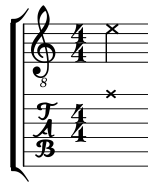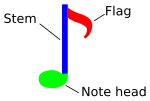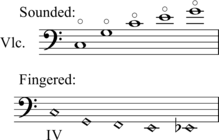
Medieval music encompasses the sacred and secular music of Western Europe during the Middle Ages, from approximately the 6th to 15th centuries. It is the first and longest major era of Western classical music and followed by the Renaissance music; the two eras comprise what musicologists generally term as early music, preceding the common practice period. Following the traditional division of the Middle Ages, medieval music can be divided into Early (500–1000), High (1000–1300), and Late (1300–1400) medieval music.

Musical notation is any system used to visually represent auditorily perceived music, played with instruments or sung by the human voice through the use of symbols, including notation for durations of absence of sound such as rests. The act of deciphering or reading a piece using musical notation, is known as "reading music".

Renaissance music is traditionally understood to cover European music of the 15th and 16th centuries, later than the Renaissance era as it is understood in other disciplines. Rather than starting from the early 14th-century ars nova, the Trecento music was treated by musicology as a coda to Medieval music and the new era dated from the rise of triadic harmony and the spread of the contenance angloise style from Britain to the Burgundian School. A convenient watershed for its end is the adoption of basso continuo at the beginning of the Baroque period.
In Western musical notation, the staff, also occasionally referred to as a pentagram, is a set of five horizontal lines and four spaces that each represent a different musical pitch or in the case of a percussion staff, different percussion instruments. Appropriate music symbols, depending on the intended effect, are placed on the staff according to their corresponding pitch or function. Musical notes are placed by pitch, percussion notes are placed by instrument, and rests and other symbols are placed by convention.
In music, tremolo, or tremolando, is a trembling effect. There are multiple types of tremolo: a rapid repetition of a note, an alternation between two different notes, or a variation in volume.

An eighth note (American) or a quaver (British) is a musical note played for one eighth the duration of a whole note (semibreve). Its length relative to other rhythmic values is as expected—e.g., half the duration of a quarter note (crotchet), one quarter the duration of a half note (minim), and twice the value of a sixteenth note. It is the equivalent of the fusa in mensural notation.

Gregorian chant is the central tradition of Western plainchant, a form of monophonic, unaccompanied sacred song in Latin of the Roman Catholic Church. Gregorian chant developed mainly in western and central Europe during the 9th and 10th centuries, with later additions and redactions. Although popular legend credits Pope Gregory I with inventing Gregorian chant, scholars believe that it arose from a later Carolingian synthesis of the Old Roman chant and Gallican chant.

In music, a double whole note (American), breve, (British) or double note lasts two times as long as a whole note. It is the second-longest note value still in use in modern music notation. The longest notated note is the longa, which could be double or triple the length of a breve, although its use is most commonly found in early music. The longest notated note is the maxima.

Ars antiqua, also called ars veterum or ars vetus, is a term used by modern scholars to refer to the Medieval music of Europe during the High Middle Ages, between approximately 1170 and 1310. This covers the period of the Notre-Dame school of polyphony, and the subsequent years which saw the early development of the motet, a highly varied choral musical composition. Usually the term ars antiqua is restricted to sacred (church) or polyphonic music, excluding the secular (non-religious) monophonic songs of the troubadours, and trouvères. Although colloquially the term ars antiqua is used more loosely to mean all European music of the 13th century, and from slightly before.

A neume is the basic element of Western and Eastern systems of musical notation prior to the invention of five-line staff notation.

A fermata is a symbol of musical notation indicating that the note should be prolonged beyond the normal duration its note value would indicate. Exactly how much longer it is held is up to the discretion of the performer or conductor, but twice as long is common. It is usually printed above but can be occasionally below the note to be extended.
Franco of Cologne was a German music theorist and possibly a composer. He was one of the most influential theorists of the Late Middle Ages, and was the first to propose an idea which was to transform musical notation permanently: that the duration of any note should be determined by its appearance on the page, and not from context alone. The result was Franconian notation, described most famously in his Ars cantus mensurabilis.
Johannes de Garlandia was a French music theorist of the late ars antiqua period of medieval music. He is known for his work on the first treatise to explore the practice of musical notation of rhythm, De Mensurabili Musica.

In medieval music, the rhythmic modes were set patterns of long and short durations. The value of each note is not determined by the form of the written note, but rather by its position within a group of notes written as a single figure called a ligature, and by the position of the ligature relative to other ligatures. Modal notation was developed by the composers of the Notre Dame school from 1170 to 1250, replacing the even and unmeasured rhythm of early polyphony and plainchant with patterns based on the metric feet of classical poetry, and was the first step towards the development of modern mensural notation. The rhythmic modes of Notre Dame Polyphony were the first coherent system of rhythmic notation developed in Western music since antiquity.

In music notation, a note value indicates the relative duration of a note, using the texture or shape of the notehead, the presence or absence of a stem, and the presence or absence of flags/beams/hooks/tails. Unmodified note values are fractional powers of two, for example one, one-half, one fourth, etc.

Mensural notation is the musical notation system used for polyphonic European vocal music from the late 13th century until the early 17th century. The term "mensural" refers to the ability of this system to describe precisely measured rhythmic durations in terms of numerical proportions between note values. Its modern name is inspired by the terminology of medieval theorists, who used terms like musica mensurata or cantus mensurabilis to refer to the rhythmically defined polyphonic music of their age, as opposed to musica plana or musica choralis, i.e., Gregorian plainchant. Mensural notation was employed principally for compositions in the tradition of vocal polyphony, whereas plainchant retained its own, older system of neume notation throughout the period. Besides these, some purely instrumental music could be written in various forms of instrument-specific tablature notation.

In musical notation, a beam is a horizontal or diagonal line used to connect multiple consecutive notes to indicate rhythmic grouping. Only eighth notes (quavers) or shorter can be beamed. The number of beams is equal to the number of flags that would be present on an unbeamed note. Beaming refers to the conventions and use of beams. A primary beam connects a note group unbroken, while a secondary beam is interrupted or partially broken.
Percussion notation is a type of musical notation indicating notes to be played by percussion instruments. As with other forms of musical notation, sounds are represented by symbols which are usually written onto a musical staff.

In music, notably in jazz, a ghost note is a musical note with a rhythmic value, but no discernible pitch when played. In musical notation, this is represented by an "X" for a note head instead of an oval, or parentheses around the note head. It should not be confused with the X-shaped notation that raises a note to a double sharp.


















